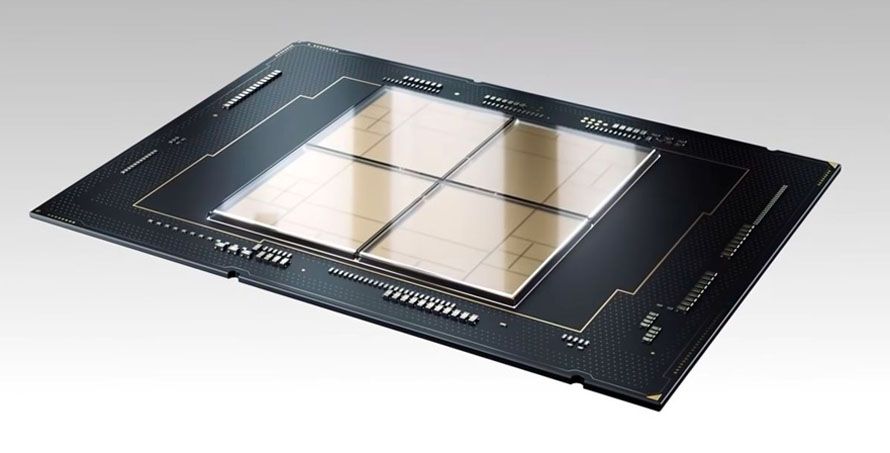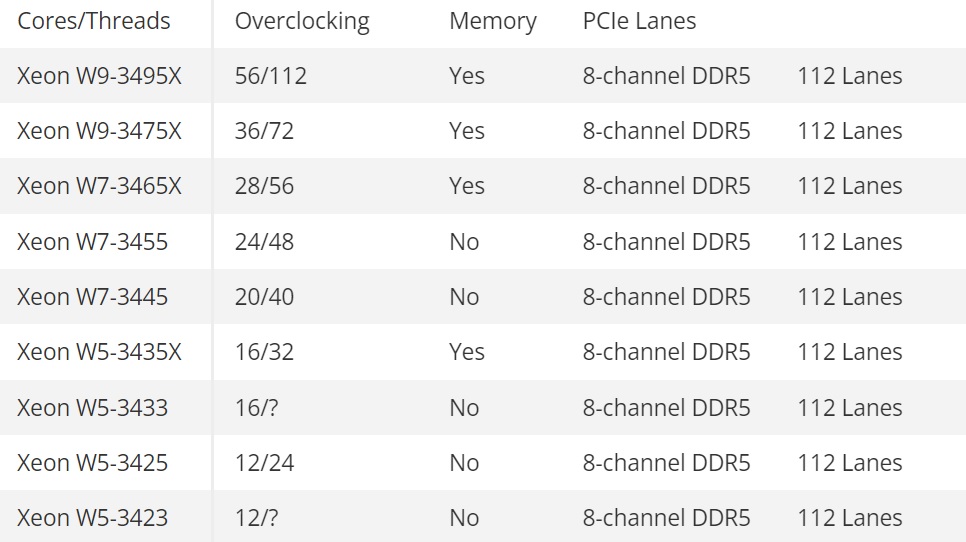
Intel Sapphire Rapids-WS Lineup Leaks: Up to 56 Cores With Overclocking
Intel’s plans for the workstation market with its Sapphire Rapids-WS are taking shape as a well-known hardware leaker published preliminary specifications for the new CPUs. Intel’s lineup of next-generation Xeon products for workstations and high-end desktops will include overclockable CPUs with up to 56 cores, eight memory channels, and 112 PCIe lanes if the information revealed by reputable hardware leaker Enthusiastic Citizen (ECSM_Official) is correct.
The New Family of Workstation CPUs from Intel
Intel’s family of next-generation Xeon W processors for W790-based workstations will reportedly consist of two families of products that will offer slightly different capabilities. The Xeon W 3400-series CPUs will be derived from a multi-chiplet Sapphire Rapids design and will feature up to 56 cores, eight DDR5 memory channels, and 112 PCIe lanes. In addition, CPU cores used by these processors will be Golden Cove-derived cores with AVX-512 and AMX instructions enabled. By contrast, the Xeon W-2400-series processors will use a single-die design with up to 24 cores, four DDR5 memory channels, and 64 PCIe lanes.
Intel’s Xeon W-2400 and W3400-series processors are expected to come in LGA4677 packaging and use W790-based workstation motherboards. One of the first W790 mainboards leaked last week, which suggests that some of Intel’s partners are getting ready to ship these products sooner rather than later. Meanwhile, a rumor suggests that Intel only intends to roll out its W790 platform next April, so it is too early to ship appropriate motherboards. Then again, Intel has never officially confirmed the launch timeframe for its W790 platform and only confirmed that this one is designed for workstations.
Intel Xeon W-3400: Up to 56 Overclockable Cores
Intel’s Xeon W-3400-series lineup will allegedly include nine models, four of which will be overclockable. Even the flagship Xeon W9-3495X is expected to come with an unlocked multiplier making for overclocking support.

Linux boot logs unearthed earlier this year essentially confirm the existence of Intel’s Xeon W-3400-series CPUs (which come with AVX-512 and AMX enabled). Still, they also mention the Xeon W9-3495 (non-X) CPU clocked at 1.80 GHz base, which Enthusiastic Citizen does not list. We have no idea whether Intel changed its plans concerning its Sapphire Rapids-WS lineup since July, but we are dealing with preliminary information, so some details may be inaccurate.
Intel’s Xeon W-3400-series relies on Sapphire Rapids silicon, which will offer AVX-512 support and AMX instructions for artificial intelligence and machine learning applications. Advanced Matrix Extensions is a tiled matrix multiplication accelerator, a grid of fused multiply-add units supporting BF16 and INT8 input types that can be programmed using only 12 instructions and perform up to 1024 TMUL BF16 or 2048 TMUL INT8 operations per cycle per core.
Currently, there are no workstation-grade CPUs featuring up to 56 cores and AVX-512 instructions, so this will be a tangible advantage of Intel’s X-3400-series processors over existing AMD’s Ryzen Threadripper Pro 5000WX-series products. Meanwhile, AMD is working on the next-generation Zen 4-based Ryzen Threadripper Pro 7000WX family codenamed Storm Peak that will also support AVX-512, but we have no idea when these CPUs are set to become available.
What will truly set Intel’s Xeon W-3400 apart from the competition is AMX support since these instructions will make it extremely competitive in AI/ML and other types of matrix multiplication workloads. One may argue that workstations hardly run such applications, but someone has to develop and try AMX-supporting applications on something, and they will likely opt for a Xeon W-3400-based machine. Furthermore, once workstation programs learn how to use AMX properly, Sapphire Rapids-WS-based devices will have an advantage over the competition for some time.
Intel Xeon W-2400: Up to 24 Overclockable Cores
Intel’s Xeon W-2400-series family will reportedly comprise eight SKUs, four of which will be overclockable. While we cannot state this for sure, but we suspect that the W2000-series will use Intel’s 34-core Raptor Lake-S silicon. Meanwhile, even the range-topping Xeon W7-2495X features 24 cores with Hyper-Threading. Perhaps, Intel yet has to disclose additional Xeon W-2400-series models with higher core counts to partners. Or maybe the company decided to sacrifice eight cores for additional yields, clocks, or perhaps decent clocks for AVX-512.
Three interesting SKUs that Intel allegedly has in the Xeon W-2400 lineup are the eight-core W5-2435 as well as the six-core W3-2425 and W3-2423 processors. Assuming that these chips can be overclocked by raising BCLK frequency (we are not sure this will work on a workstation-grade W790 platform, but who knows?), they will certainly attract the attention of the world’s top professional overclockers. Meanwhile, we can only wonder whether these parts will be successful commercially or share the fate of Intel’s Kaby Lake-X processors for the X299 platform aimed at enthusiasts.
It is noteworthy that the Xeon W4-2423 processor does not support Hyper-Threading, according to Enthusiastic Citizen, which is a big surprise for a 2023 workstation processor. Interestingly, there are also Xeon W5-3433 and W5-3423 processors in the 3400-series family, but there is no word whether they support simultaneous multithreading.
Worthy Contender? Maybe
Intel’s Xeon W-3000 and W-2000-series processors could give AMD’s Ryzen Threadripper Pro a good run for their money if the information is correct. Yet, while Enthusiastic Citizen tends to be very accurate and therefore has a good reputation, we are still dealing with unofficial information, so take it with a grain of salt.